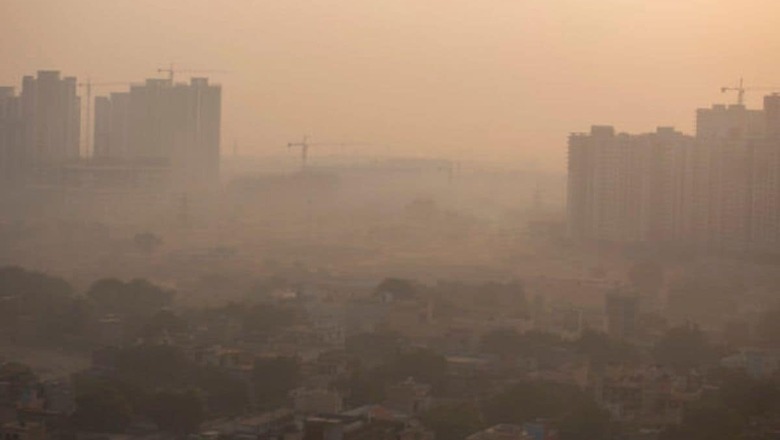
views
Of all the things that cross your attention when shopping for the festive season in India, if you live in the National Capital Region of India over the past few years, an air purifier must have crossed your mind. With the air quality index (AQI) soaring past 400 in Noida as per numerous sources, now might be the perfect time for you to get an air purifier for your home. However, do air purifiers really work? Being gadgets whose working you can not really see, plenty of questions have remained around whether an air purifier really makes a major difference at home, and if the difference is big enough to have an impact on your health.
Explaining the invisible
Speaking to News18, Michael Leat, design engineer for Dyson, states that while outdoor air quality is far better studied and understood, the level of information and understanding on indoor air quality and its long-term impact on human health is still developing. “Outdoor air quality is better understood, and studies indicate that there’s potentially a significant impact on health in the long run. Respiratory issues in adults and lung development in children are the main effects observed. However, for indoor air, our homes are increasingly sealed for air conditioning and heating efficiency, which makes stagnant air recirculate inside. Given the already-bad air quality outdoors, the air inside homes can potentially have a bigger impact on health than what you breathe outside,” he says.
While this is a real issue, the trick often lies in explaining to a person how the air quality inside is affected. Practically every household item and action – common ones such as cooking, cleaning, furniture polishing and the likes – have an impact on the quality of air inside our homes. As a result, Leat says that the key is in visualising the invisible to users in the form of data, which then helps them tally a spike in PM2.5 (particulate matter smaller than 2.5 microns) or VOCs (volatile organic compounds) with a specific action being done inside a house.
“Our first purifiers had the ability to sense pollutants and respond accordingly. But, people didn’t know why it was responding, and what the problem was, so there was a major disconnect for their understanding of how and why the purifier was working. In Dyson’s latest generation purifiers, we’ve added screens that show what type of pollutants the purifier is responding to, hence showing how it works. This can improve individual understanding of air quality events at home,” says Leat. Dyson also has a smartphone app, which shows tabulated daily and weekly data in terms of PM2.5, PM10, VOC, NO2, temperature and humidity levels at your home.
The impact of bad air at home
Arun Verma, head of the research and development department at American Air Filter International, says that WHO’s indicative guidelines for outdoor air quality in Europe should serve as a standard to follow for indoor air in India, given the disparity in pollution between the two regions. On this note, Verma highlights that while Europe so far followed the EN779 standard for air quality, and USA adopted ASHRAE 52.2, India had no real standard established, leading to no real control on air quality inside homes.
Today, ISO 16890 is seemingly tying these knots together. As Verma says, “According to its particulate matter guidelines, which Europe has already adopted, they specify a minimum performance of 50 percent efficiency for PM2.5 and PM1 filters to meet health standards. The World Health Organisation (WHO) guideline has necessitated ISO 16890 to establish maximum permissible air particulate matter levels such as PM2.5, which stands at 25ug/m3 for air to be rated ‘good’. Establishing these standards is really important to understand how bad the air is around us, and take its impact on health and long-term diseases seriously.”
A research study in the Lung India journal by the Indian Chest Society, published in October 2015, further underlines how massive an impact can not filtering the air at home have on you. “The WHO fact sheet on household air pollution (HAP) due to indoor pollutants states that 3.8 million premature deaths occur annually – including stroke, ischaemic heart diseases, chronic obstructive pulmonary diseases (COPD) and lung cancer, all of which are attributed to exposure to household air pollution,” says the study titled ‘Enhancing indoor air quality – The air filter advantage’ by Vannan Kandi Vijayan, Haralappa Paramesh, Sundeep Santosh Salvi and Alpa Anil Kumar Dalal.
Lack of awareness
The United States Environmental Protection Agency (EPA) also notes a range of both immediate and long-term effects of indoor air pollution, which has corresponding effects on personal health. Despite this, AAF’s Verma says that indoor air filtration is only treated as regulation, and a lack of awareness is one of the key factors. “Any building that has lead certification to be rated as a green building has to have a two-step air filtration method all through. Hence, some of these industrial setups have air filtration, but I believe that it is not by choice,” Gupta affirms.
Gupta also states that most industrial air purification setups do not require additional infrastructure. However, the objective of looking for the cheapest way to tick the air filtration checkbox often leads to undesirable results. On a personal deployment front, Dyson’s Leat states that it is this that the company started doing differently from others. “When we started testing, the only standard methodology available was CADR, which has been around for over 30 years. It’s conducted in a small room, with a purifier that is placed in the middle of the room. It uses a fan to keep the pollutants mixed in the room, and has a ceiling fan to start the test off. There are elements in this that aren’t realistic to our real-world homes – for instance, nobody puts a purifier in the middle of a room,” he adds.
It is this that Leat says helped Dyson come up with its Polar testing mechanism, and the ‘sense, capture, project’ air purification strategy. At the core of this is setting up product testing and data collection in line with the real world, all of which combines to reduce misinformation and lack of awareness around indoor air pollution, and the role of an air purifier in today’s world.
Read all the Latest News, Breaking News and Coronavirus News here



















Comments
0 comment